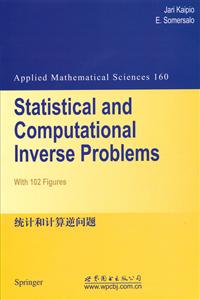-
>
宇宙、量子和人類心靈
-
>
氣候文明史
-
>
南極100天
-
>
考研數學專題練1200題
-
>
希格斯:“上帝粒子”的發明與發現
-
>
神農架疊層石:10多億年前遠古海洋微生物建造的大堡礁
-
>
聲音簡史
統計和計算逆問題 版權信息
- ISBN:9787510086311
- 條形碼:9787510086311 ; 978-7-5100-8631-1
- 裝幀:一般膠版紙
- 冊數:暫無
- 重量:暫無
- 所屬分類:>>
統計和計算逆問題 內容簡介
This book is aimed at postgraduate students in applied mathematics as well as at engineering and physics students with a firm background in mathematics. The first four chapters can be used as the material for a first course on inverse problems with a focus on computational and statistical aspects. On the other hand, Chapters 3 and 4, which discuss statistical and nonstationary inversion methods, can be used by students already having knowldege of classical inversion methods. There is rich literature, including numerous textbooks, on the classical aspects of inverse problems. From the numerical point of view, these books concentrate on problems in which the measurement errors are either very small or in,which the error properties are known exactly. In real world problems, however, the errors are seldom very small and their properties in the deterministic sense are not well known. For example, in classical literature the error norm is usually assumed to be a known real number. In reality, the error norm is a random variable whose mean might be known.
統計和計算逆問題 目錄
1 Inverse Problems and Interpretation of Measurements
1.1 Introductory Examples
1.2 Inverse Crimes
2 Classical Regularization Methods
2.1 Introduction: Fredholm Equation
2.2 Truncated Singular Value Decomposition
2.3 Tikhonov Regularization
2.3.1 Generalizations of the Tikhonov Regularization
2.4 Regularization by Truncated Iterative Methods
2.4.1 Landweber-Fridman Iteration
2.4.2 Kaczmarz Iteration and ART
2.4.3 Krylov Subspace Methods
2.5 Notes and Comments
3 Statistical Inversion Theory
3.1 Inverse Problems and Bayes' Formula
3.1.1 Estimators
3.2 Construction of the Likelihood Function
3.2.1 Additive Noise
3.2.2 Other Explicit Noise Models
3.2.3 Counting Process Data
3.3 Prior Models
3.3.1 Gaussian Priors
3.3.2 Impulse Prior Densities
3.3.3 Discontinuities
3.3.4 Markov Random Fields
3.3.5 Sample-based Densities
3.4 Gaussian Densities
3.4.1 Gaussian Smoothness Priors
3.5 Interpreting the Posterior Distribution
3.6 Markov Chain Monte Carlo Methods
3.6.1 The Basic Idea
3.6.2 Metropolis-Hastings Construction of the Kernel
3.6.3 Gibbs Sampler
3.6.4 Convergence
3.7 Hierarcical Models
3.8 Notes and Comments
4 Nonstationary Inverse Problems
4.1 Bayesian Filtering
4.1.1 A Nonstationary Inverse Problem
4.1.2 Evolution and Observation Models
4.2 Kalman Filters
4.2.1 Linear Gaussian Problems
4.2.2 Extended Kalman Filters
4.3 Particle Filters
4.4 Spatial Priors
4.5 Fixed-lag and Fixed-interval Smoothing
4.6 Higher-order Markov Models
4.7 Notes and Comments
5 Classical Methods Revisited
5.1 Estimation Theory
5.1.1 Maximum Likelihood Estimation
5.1.2 Estimators Induced by Bayes Costs
5.1.3 Estimation Error with Affine Estimators
5.2 Test Cases
5.2.1 Prior Distributions
5.2.2 Observation Operators
5.2.3 The Additive Noise Models
5.2.4 Test Problems
5.3 Sample-Based Error Analysis
5.4 Truncated Singular Value Decomposition
5.5 Conjugate Gradient.Iteration
5.6 Tikhonov Regularization
5.6.1 Prior Structure and Regularization Level
5.6.2 Misspeeification of the Gaussian Observation Error Model
5.6.3 Additive Cauchy Errors
5.7 Diseretization and Prior Models
5.8 Statistical Model Reduction, Approximation Errors and Inverse Crimes
5.8.1 An Example: Full Angle Tomography and CGNE
5.9 Notes and Comments
6 Model Problems
6.1 X-ray Tomography
6.1.1 Radon Transform
6.1.2 Discrete Model
6.2 Inverse Source Problems
6.2.1 Quasi-static Maxwell's Equations
6.2.2 Electric Inverse Source Problems
6.2.3 Magnetic Inverse Source Problems
6.3 Impedance Tomography
6.4 Optical Tomography
6.4.1 The Radiation Transfer Equation
6.4.2 Diffusion Approximation
6.4.3 Time-harmonic Measurement
6.5 Notes and Comments
7 Case Studies
7.1 Image Deblurring and Recovery of Anomalies
7.1.1 The Model Problem
7.1.2 Reduced and Approximation Error Models
7.1.3 Sampling the Posterior Distribution
7.1.4 Effects of Modelling Errors
7.2 Limited Angle Tomography: Dental X-ray Imaging
7.2.1 The Layer Estimation
7.2.2 MAP Estimates
7.2.3 Sampling: Gibbs Sampler
7.3 Biomagnetic Inverse Problem: Source Localization
7.3.1 Reconstruction with Gaussian White Noise Prior Model
7.3.2 Reconstruction of Dipole Strengths with the e1-prior Model
7.4 Dynamic MEG by Bayes Filtering
7.4.1 A Single Dipole Model
7.4.2 More Realistic Geometry
7.4.3 Multiple Dipole Models
7.5 Electrical Impedance Tomography: Optimal Current Patterns
7.5.1 A Posteriori Synthesized Current Patterns
7.5.2 Optimization Criterion
7.5.3 Numerical Examples
7.6 Electrical Impedance Tomography: Handling Approximation Errors
7.6.1 Meshes and Projectors
7.6.2 The Prior Distribution and the Prior Model
7.6.3 The Enhanced Error Model
7.6.4 The MAP Estimates
7.7 Electrical Impedance Process Tomography
7.7.1 The Evolution Model
7.7.2 The Observation Model and the Computational Scheme
7.7.3 The Fixed-lag State Estimate
7.7.4 Estimation of the Flow Profile
7.8 Optical Tomography in Anisotropic Media
7.8.1 The Anisotropy Model
7.8.2 Linearized Model
7.9 Optical Tomography: Boundary Recovery
7.9.1 The General Elliptic Case
7.9.2 Application to Optical Diffusion Tomography
7.10 Notes and Comments
A Appendix: Linear Algebra and Functional Analysis
A.1 Linear Algebra
A.2 Functional Analysis
A.3 Sobolev Spaces
B Appendix 2: Basics on Probability
B.1 Basic Concepts
B.2 Conditional Probabilities
References
Index
統計和計算逆問題 作者簡介
Jari Kaipio(J. 凱皮奧,芬蘭)是國際知名學者,在數學和物理學界享有盛譽。本書凝聚了作者多年科研和教學成果,適用于科研工作者、高校教師和研究生。
- >
詩經-先民的歌唱
- >
伯納黛特,你要去哪(2021新版)
- >
李白與唐代文化
- >
名家帶你讀魯迅:故事新編
- >
企鵝口袋書系列·偉大的思想20:論自然選擇(英漢雙語)
- >
上帝之肋:男人的真實旅程
- >
我從未如此眷戀人間
- >
中國人在烏蘇里邊疆區:歷史與人類學概述















